FRIDAY'S SCRIPT TIP:
PLANTS & PAY OFFS

Throughout your script you should be
"planting" plot, character,
dialogue and actions that you can later "pay off" to create an
emotional response in the audience. We want the audience to feel
what our characters feel, to have an emotional experience. Plants
and pay offs are important tools we can use to reveal information
and create an emotionally charged moment for the audience.
There are three kinds of Plants: Establishing, Reveal/Surprise,
and Soft Plants. The plants are pretty much the same, but the way
they Pay Off is very different. All three deal with establishing
information - but what happens after that are three different roads
to three different conclusions.
A Reveal/Surprise Plant is designed so that the audience *forgets*
the information that is planted so that when it is revealed later in
the story it is some form of surprise or "That's right! She always
wears a bullet proof vest!" The Establishing Plant is designed to
*remind* the audience of a goal or skill or some other bit of information
so that they do not forget it. The Soft Plant is the most interesting of
the three because it is just information that is established that may
*never* Pay Off. Never. It's optional. I often use Soft Plants when
writing - I establish some piece of information that I have no planned
Pay Off for - but maybe I'll come up with some use for that information
later in the script... or maybe I won't and it's just an interesting
detail about character or location or some other aspect of the story.
In James Cameron's ALIENS every single character is given a
little story that pays off at the end. The cowardly commander
who tries to fight the war from the armored vehicle ends up
showing courage by sacrificing himself on the front lines so that
the others can get away. Vasquez, who hates the commander and
makes fun of him throughout the film, is at his side - showing
that she respects him. Ripley hates androids, won't even sit at
the same table as Lance Henrickson's character - but he's the one
who dies trying to save her at the end. The supporting
character's conflict is planted early, and paid off at the
end.

In the second scene of Jeff Nathanson's CATCH ME IF YOU CAN we see Leonardo DiCaprio
at a Rotary Club dinner honoring his father (Christopher Walken). As he listens to his father tell a story,
DiCaprio slowly peels the labels off a bottle of champagne - trying to keep it intact. Though you may
think this was just something for the character to do while his dad tells his oft-told tale, in reality it's a
plant that will pay off in two very different ways.
First - Leo peels the Pan Am decals off of model
planes to force checks (that nervous habit comes in handy).
Second - when FBI Agent Tom Hanks
confronts Leo in a Los Angeles apartment, Leo claims to be a fellow Federal Agent and hands him his
ID folder. By the time Hanks flips open the ID folder, Leo is long gone. The ID folder is filled with
labels peeled from products. This is both a plant AND a pay off. When Hanks sees the peeled labels in
the ID folder he knows the federal agent is really Leo the forger... and it plants the peeled label habit in
Hanks' knowledge of Leo (Hanks is not a psychic - we needed a scene that connects the peeled labels
to Leo).
Later in the film, Hanks and his team are searching for Leo and end up at a society wedding.
Not much chance that the groom is their lower-middle class forger. Hanks is ready to leave when he
sees the champagne bottle with the peeled label. That's the pay off! The real reason we say Leo peeling
off that label in the opening scene. The minute he sees that champagne bottle Hanks KNOWS that Leo
is the groom... and currently only a few feet away in an upstairs bedroom! Because the plant and pay
off are VISUAL we don't need anyone to tell us that Hanks has figured out Leo is locked in that
bedroom upstairs. We figure it out based on the visual plant from that second scene.
DARK SALVAGE

My screenplay DARK SALVAGE got me a bunch of studio meetings - it's Indiana Jones in swim fins. A huge epic adventure about sunken Spanish Galleons
and two crews that go after the same treasure. Everybody loved it... but the
main reason why it didn't sell is because it takes place both on and under water,
which was very expensive to shoot at the time. The most mentioned film was WATERWORLD. Maybe now that CGI is better, and those
PIRATES movies were hits that they are still trying to revive, someone might be interested in it now?
I think one of the reasons why the script got me so many meetings was that I used plants and pay offs throughout the
script to show the relationship between characters evolving, or
just to create a clever reveal later in the story. The ship our heroes rent has a battered old refrigerator covered in
refrigerator magnets... which vanish in one scene. Well, the way you find sunken treasure is with a magnetometer - and it's
later revealed that the hero has used the magnets to throw the villain's team off. This plant and pay off
adds character to my comic relief Horner character (who owns the boat and the refrigerator)... then makes our hero our hero Lonnie look clever (when he plants the magnets away from
the real potential treasure sites)... then
pays off again when the villain Curt discovers them. Those magnets also have
a "reverse pay off" when leading lady Shelby sees a reflection of an attacking henchman in the
refrigerator door that wouldn't be visible if the magnets hadn't
been removed. My goal here was to take a "prop" like the refrigerator magnets and make them integral to the story... again and again. Something mundane that was
"character and location information" for the Horner character, but secretly creates twists in the story at least two times.
Every character in DARK
SALVAGE has plants and pay offs, but
let's look at (sidekick) Carter and (hero) Lonnie's relationship. After seeing too
many films where the hero had a wise old mentor, I decided to
turn that upside down and make my hero the mentor character. So I
needed a student - Carter. Carter's character helps the story in
many ways:
1) Because no modern movie has ever been about marine salvage
divers, I needed a "new guy" to act as an audience surrogate. All
of the technical stuff could be explained to the audience by
having (hero) Lonnie or (sidekick) Shelby explain it to Carter.
2) Carter also acts as a reflection of Lonnie. We can chart
Lonnie's character arc through his relationship with Carter, and
see where Lonnie DOESN'T change in scenes where Carter DOES
change. Having a "control" character in your experiment can help you tell the story without using a sledgehammer.
3) Carter also adds some comedy relief. Shelby is sarcastic,
but I needed a character that was a little goofy. Someone who could
do and say silly things to balance the heavy tone of the
Lonnie/Curt (hero/villain) and Lonnie/Evelyn (hero/femme fatale) stories.
4) That reverse mentor thing: Lonnie sees himself in Carter.
He
sees the guy he used to be, and sees the potential. So Carter
will bring out Lonnie's character - especially his optimism and
his belief that good deeds pay off. Lonnie is such a bitter
character at the beginning of this story that I needed a way to show his sweetness.

Okay, that's why Carter's a character in DARK
SALVAGE, so now
let's look at some of *his* plants and pay offs.
PLANT: The first scene with Lonnie and Carter I wanted
to show
how similar they were. So I invented this sunken DC-3 off the
coast of Gualala that Carter was going to dive and Lonnie had
dove years ago. That DC-3 was never intended to be a plant! Total soft plant - when I wrote
the scene I just needed to show scuba diving!
PAY OFF: Near the end of the script I had a big dramatic
scene
between Carter and Lonnie. His friendship with Carter was turning
out the way his friendship with Williams had turned out. Lonnie
was angry (a pair of dive knives pay off here) - but there are no one
sided arguments. So what could Carter throw back in Lonnie's
face? How about that sunken DC-3?
It's important to plant as many details in your script as
possible - to give characters full, rich, lives and surroundings
so that you have material to pay off later. The best thing about
pay offs from soft plants like this is that they surprise you (the writer). You
had no idea that little detail would become a pivotal part of the
script when you wrote it. If you plant a great little detail and
it never pays off, that's okay! A great little detail makes the
character more real - which is a different kind of pay off.
PLANT: Carter's frustration with being "top man" - he
wants to be
a diver on the salvage mission.
PAY OFF: Carter finds a very unexpected way to be a
diver on the
salvage mission... by joining the villain!
PLANT: Carter tells Lonnie he wants to "Hold the gold
in my hand,
that's what it's all about."
PAY OFF: At the end of the script, Lonnie helps Carter get
his
wish to hold the gold in his hand. This is an emotional moment -
set up earlier in the script so that I could pay it off here.
When Carter's line plants this scene, you don't expect it to pay
off like this. That's the key to a good Reveal/Surprise Plant & Pay Off - even if
the audience anticipates the pay off, you surprise them by paying
it off in an unexpected way. You want to keep the cause and
effect between plant and pay off, but you don't want the audience
to be able to predict the effect.
Sometimes you can use plants & pay offs to create mystery. In
an
early scene femme fatale Eveyln does something unexpected - she starts a shoot
out with the villain Williams. Why? Hey, folks, that's a plant! I wanted the
audience to wonder why she did that, so that I could build
mystery around her character. She's already the unknown person on
the boat. Another part of the plant is that she used to dive with
Williams. I continue to plant information that acts as clues to
"the Evelyn mystery" - she secretly meets Williams for drinks
when they go to shore (pay off of the Evelyn's lipstick plant),
her dive knives match the punctured canned goods, and the BIG
plant I slip in when no one is looking: She talks about this
business associate of her father's who slept with her and dumped
her - now they hate each other. If you're assembling the clues to
the "Evelyn mystery" that last plant solves it... it's really a
pay off! But the confirmation comes 23 pages later when I pay off
the entire Evelyn mystery in a big dramatic scene with
Lonnie... she used to be William's lover & protege.
Other plants & pay offs in the script: the coffee with egg
shell,
the bar tabs (a running gag), Shelby not feeling needed by
Lonnie, the story of Ron Ennio, the "easiest million I ever
earned", beer consumption (another running gag), the magnetometer
hits, the cannon, the Green King wreckage, the "rain check", and
how all of the dive shop guys in the beginning of the script
show up by the end of the script! There are so many plants & pay
offs that I could nerver list them all... I haven't even
mentioned the entire Lonnnie/Williams relationship that's FULL of
plants, pay offs, and past incidents coming back to haunt the
characters.
SOFT PLANTS
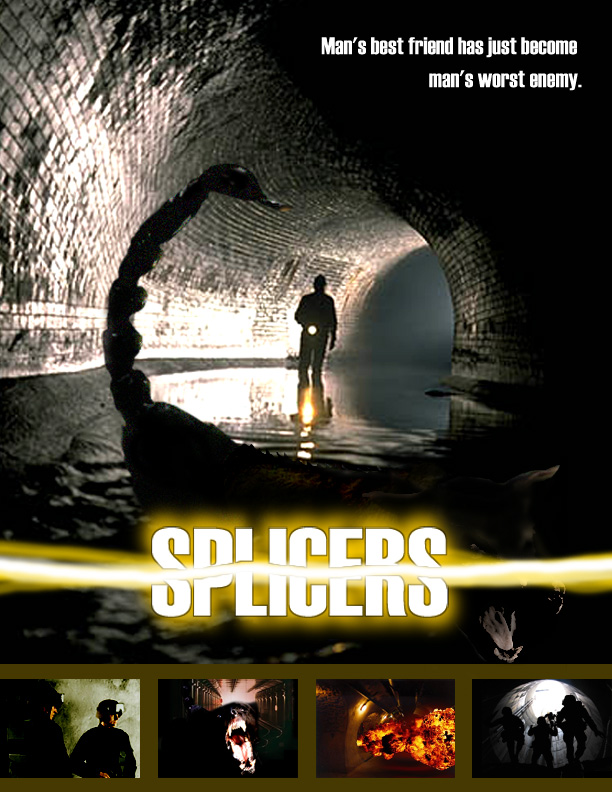
Sometimes you may plat something with no payoff in mind. In my script SPLICERS (also always a bridesmaid and never a bride) , I had a scene where our soldier hero first meets
the female soldier love interest he admires her chrome 45s and asks to take
a look at them. She shoots him down with "I don't know you that well." That started out as just
a line of dialogue, but ended up being used a couple more times in the
script... it "accidentally" paid off later.
Another accidental plant was a soldier who was killed early on...
and later in the script I had my hero at the same location in need of a weapon.
I tried to figure out what he could use as a weapon, then I remembered
the dead soldier... and his weapon. Hey, a great accidental plant!
I also gave each character in SPLICERS an emotional conflict (plant) that
could be resolved later in the script. Another female soldier has a hot date and wants to get the mission over with as quickly as possible.
Orginally the hot date was just a way to define her character, but it ended up paying off
by the end of the film when she sacrifices herself and stays behind so that others can escape...
and that means she'll miss her date.
Give each of your characters a plant (conflict) early that
will
be resolved in later scenes so that they can help save the day or
create an emotional pay off with your protagonist. Fill your
script with as many details that not only add verisimilitude but
give you material that you can pay off later. Find the unexpected
way to pay off your plants to keep your script unpredictable. You
can't have too many clever plants and pay offs!
Reveal/Surprise Plants: are designed for the audience *not* to remember the information you have established.
Establishing Plants: are designed for the audience to remember the information you have established.
Soft Plants: are information established which may never pay off! It might just be a cool detail... or may end up that secret weapon in James Bond's briefcase you never thought he'd use.
It's always about what you want the audience to feel and what you want them to know... *how* you tell the story.
Okay, enough about my scripts that were near misses...
BRAND NEW!
How Do I do That?

101 SCREENWRITING ANSWERS Blue Book!
New to screenwriting? You probably have questions! How do I get an Agent? How do I write a phone conversation? Do I need a Mentor? What’s does VO and OC and OS mean? What is proper screenplay format? Should I use a pen name? Do I need to movie to Hollywood? What’s the difference between a Producer and a Production Manager, and which should I sell my script to? How do I write a Text Message? Should I Copyright or WGA register my script? Can I Direct or Star? How do I write an Improvised scene? Overcoming Writer’s Block? How do I write a Sex Scene? And many many more! This book has the answers to the 101 Most Asked Questions from new screenwriters! Everything you need to know to begin writing your screenplay!
All of the answers you need to know, from a working professional screenwriter with 20 produced films and a new movie made for a major streaming service in 2023!
Only $4.99
NEW!!!
Can You Make It bigger?

BLOCKBUSTERS (and BEACH READS) Blue Book!
Writing something EPIC?
Over 500 Pages, ONLY : $4.99!
Thinking about writing a big Disaster Movie? An Historical Epic? An Epic Adventure Film? Or maybe you like Gladiator Movies? This book looks at writing Blockbusters and those Big Fat Beach Read novels - anything epic! Usng movies like JAWS, POSEIDON ADVENTURE, LAWRENCE OF ARABIA, THE GUNS OF NAVARONE, and those MARVEL and FAST & FURIOUS flicks as examples. What *is* a Blockbuster? 107 years of Blockbuster history! Blockbuster Characters. Blockbuster Story Types! Why modern Blockbusters are soap operas! Social Issues in Blcokbusters? Big Emotions! Keeping All Of Those Characters Distinctive! How to avoid the Big problems found in Big Movies and books! More! If you are writing a Big Event Movie or a Big Fat Novel, there are tips and techniques to help you!
Only $4.99
NEW!!
All About Endings!
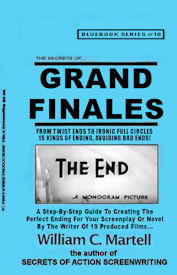
GRAND FINALES Blue Book!
The Perfect Ending For Your Story!
The First Ten Pages Of Your Screenplay Are Critical,
But What About The Last 10 Pages?
Creating the perfect ending to your story! This 100,000 word book shows you how to end your story with a bang, rather than a whimper. Everything from Resolution Order to Act Three Tools to Happy or Sad Endings? to How The Beginning Of Your Story Has Clues To The Ending (in case you were having trouble figuring out how the story should end) to Falling Action to How To Avoid Bad Endings to Writing The Perfect Twist Ending to Setting Up Sequels & Series to Emotional Resolutions to How To Write Post Credit Sequences to Avoiding Deus Ex Machinas, to 20 Different Types Of Ends (and how to write them) and much more! Everything about endings for your screenplay or novel!
Only$4.99
BRAND NEW
All About LOGLINES, TREATMENTS, and PITCHING!

LOGLINES, TREATMENTS, and PITCHING! Blue Book!
Distilling Your Screenplay!
Loglines, Treatments, Pitching, Look Books, Pitch Decks, One Pagers, Rip-O-Matics?
You have written a brilliant 110 page screenplay, but how do you get anyone to read it? You need to distill it down into some form of verbal moonshine or story rocket fuel that will ignite that bored development executive or manager or agent and get them to request your screenplay. But how do you shrink those 110 pages into a 25 word logline or a 2 minute elevator pitch or a one page synopsis or a short paragraph? This 100,000 word book shows you how! Everything you need to know! From common logline mistakes (and how to solve them) to how your pitch can reveal story problems to the 4 types of pitches!
272 pages - ONLY $4.99!
NEW: WRITE IT: FILM IT!

Making Your Own Movie?
Writing An Indie Film?
Writing A Low Budget Genre Script To Sell?
Writing A Made For TV Holiday Movie?
You will be writing for BUDGET. On a standard spec screenplay, you don’t have to think about budget, but these types of screenplays writing with budget in mind is critical!
If you are making your own movie, budget, is even more important - and you need to think about budget *before* you write your screenplay... or you will end up with a script that you can’t afford to make (or is a struggle to make). Everyone is making their own films these days, and even if you have done it before there are lots of great techniques in this book to get more money on screen - for less money! You can make a film that looks like it cost millions for pocket change.
344 pages - SALE:: $7.99!
NEW!

THE MISSION IMPOSSIBLE MOVIES
NEW: Updates On Films 7 & 8 Casting!
All Six Movies analyzed! All of the mission tapes, all of the “that’s impossible!” set pieces and stunts, the cons and capers - and how these scenes work, the twists and double crosses, the tension and suspense (and how to generate it), the concept of each film as a stand alone with a different director calling the shots (broken in the sixth film), the gadgets, the masks, the stories, the co-stars and team members (one team member has been in every film), the stunts Tom Cruise actually did (and the ones he didn’t), and so much more! Over 120,000 words of fun info!
THE MISSION IMPOSSIBLE MOVIES - 347 pages - Only $3.99 !
NO KINDLE REQUIRED! Get the *free* app (any device, except your Mr. Coffee) on the order page on Amazon!

BRAND NEW!
*** THE BOURNE MOVIES
All five "Bourne" movies (including "Legacy" and it's potential sequels) - what are the techniques used to keep the characters and scenes exciting and involving? Reinventing the thriller genre...
or following the "formula"? Five films - each with an interesting experiment! A detailed analysis of each
of the films, the way these thrillers work... as well as a complete list of box office and critical
statistics for each film. This book is great for writers, directors, and just fans of the series.
268 pages - Only $3.99
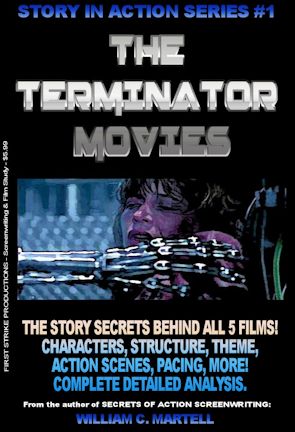
Over 240 pages!
*** THE TERMINATOR MOVIES *** - For Kindle!
He's back! The release of "Terminator: Dark Fate" is set to begin a new trilogy in
the Terminator story... 35 years after the first film was released. What draws us to these films about
a cybernetic organism from the future sent back in time? Why is there a new proposed trilogy every few
years? This book looks at all five Terminator movies from a story standpoint - what makes them work
(or not)? What are the techniques used to keep the characters and scenes exciting and involving? How
about those secret story details you may not have noticed? Containing a detailed analysis of each of
the five films so far, this book delves into the way these stories work... as well as a complete list of
box office and critical statistics for each film. This book is great for writers, directors, and just
fans of the series.
ONLY $3.99 - and no postage!
Tips FAQ

My New Script Secrets Newsletter!

NEW BOOKS!
BRAND NEW
OUTLINES & THE THEMATIC!
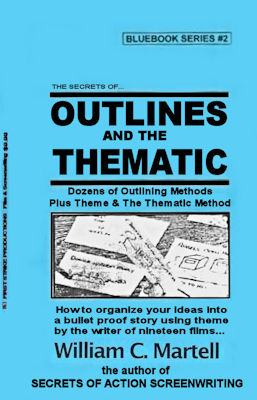
OUTLINES & THE THEMATIC Blue Book.
ARE YOUR SCENES IN THE RIGHT ORDER?
AND ARE THEY THE RIGHT SCENES?
Your story is like a road trip... but where are you going? What's the best route to get there? What are the best sights to see along the way? Just as you plan a vacation instead of just jump in the car and start driving, it's a good idea to plan your story. An artist does sketches before breaking out the oils, so why shouldn't a writer do the same? This Blue Book looks at various outlining methods used by professional screenwriters like Wesley Strick, Paul Schrader, John August, and others... as well as a guest chapter on novel outlines. Plus a whole section on the Thematic Method of generating scenes and characters and other elements that will be part of your outline. The three stages of writing are: Pre-writing, Writing, and Rewriting... this book looks at that first stage and how to use it to improve your screenplays and novels.
Only $4.99!
ALSO NEW!
DESCRIPTION & VOICE Blue Book!
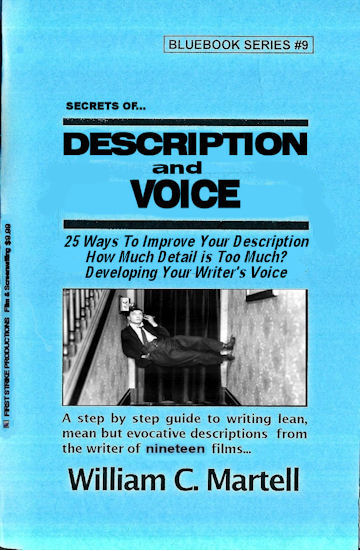
DESCRIPTION & VOICE Blue Book.
IS HALF OF YOUR STORY IN TROUBLE?
Most screenplays are about a 50/50 split between dialogue and description - which means your description is just as important as your dialogue. It just gets less press because the audience never sees it, the same reason why screenwriters get less press than movie stars. But your story will never get to the audience until readers and development executives read your script... so it is a very important factor. Until the movie is made the screenplay is the movie and must be just as exciting as the movie. So how do you make your screenplay exciting to read? Description is important in a novel as well, and the “audience” does read it... how do we write riveting description?
Only $4.99!
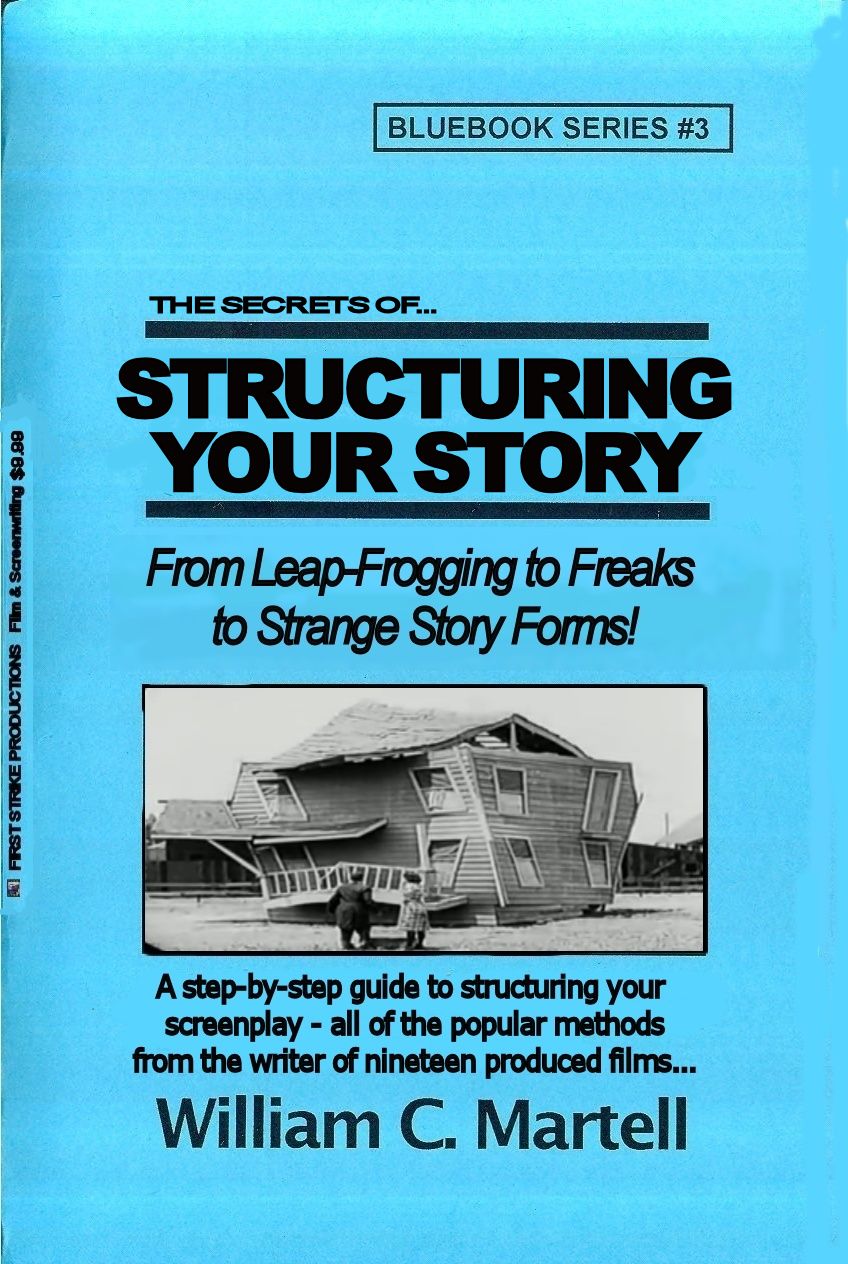
NEW AND HOT!
*** STRUCTURING YOUR STORY *** - For Kindle!
William Goldman says the most important single element of any screenplay is structure. It’s the skeleton under the flesh and blood of your story. Without it, you have a spineless, formless, mess... a slug! How do you make sure your structure is strong enough to support your story? How do you prevent your story from becoming a slug? This Blue Book explores different types of popular structures from the basic three act structure to more obscure methods like leap-frogging. We also look at structure as a verb as well as a noun, and techniques for structuring your story for maximum emotional impact. Most of the other books just look at *structure* and ignore the art of *structuring* your story. Techniques to make your story a page turner... instead of a slug!
Only $4.99 - and no postage!
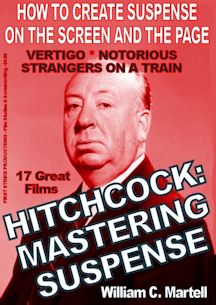
LEARN SUSPENSE FROM THE MASTER!
*** HITCHCOCK: MASTERING SUSPENSE *** - For Kindle!
Alfred Hitchcock, who directed 52 movies, was known as the *Master Of Suspense*; but what exactly is suspense and how can *we* master it? How does suspense work? How can *we* create “Hitchcockian” suspense scenes in our screenplays, novels, stories and films?
This book uses seventeen of Hitchcock’s films to show the difference between suspense and surprise, how to use “focus objects” to create suspense, the 20 iconic suspense scenes and situations, how plot twists work, using secrets for suspense, how to use Dread (the cousin of suspense) in horror stories, and dozens of other amazing storytelling lessons. From classics like “Strangers On A Train” and “The Birds” and “Vertigo” and “To Catch A Thief” to older films from the British period like “The 39 Steps” and “The Man Who Knew Too Much” to his hits from the silent era like “The Lodger” (about Jack The Ripper), we’ll look at all of the techniques to create suspense!
Only $5.99

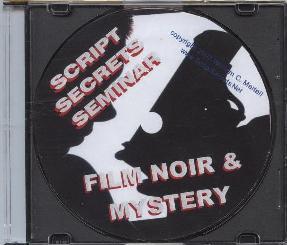
AUDIO CLASS!
NOIR & MYSTERY80 minute MP3 packed with information on writing Film Noir and Mystery scripts. Using examples from CHINATOWN to OUT OF THE PAST to DOUBLE INDEMNITY you'll learn how to create stories in this dark, twisted genre. How to plant clues, red herrings, suspects, victims, spider women, fallen heroes, the funhouse mirror world of noir supporting characters... and the origins of Film Noir in literature Noir dialogue and how noir endings are different than any other genre. All of the critical elements necessary to write in this critically popular genre.
The Noir & Mystery Class is only $15 (plus $5 S&H). First 20 on Limited Black Disk!
RECESSION SALE! $5 OFF!
IDEAS AND CREATIVITY - 80 minute MP3 packed with information. Tools to find ideas that are both personal *and* commercial. Hollywood wants scripts with High Concept stories... but not stupid scripts. Developing *intelligent* high concept ideas. How to turn your personal story into a blockbuster - or find your personal story in a high concept idea. Brainstorming and being creative. Ideas and Creativity is $10.00 (plus $5 S&H)
WRITING INDIES - Writing an Indie film? This class covers everything you need to know - from Central Locations to Confined Cameos. Using examples from SWINGERS, THE COOLER, STATION AGENT and others, this 80 minute MP3 is packed with information. How Indoe films challenge the audience (while mainstream films reassure the audience). Structures, using BOYS DON'T CRY, RUN LOLA RUN, HILARY & JACKIE, and others as example. Writing for a budget, writing for non-actors, getting the most production value out of your budget. Writing Indies is $10.00 (plus $5 S&H)
WRITING HORROR - The essentials of a horror screenplay - what do ROSEMARY'S BABY, NIGHT OF THE LIVING DEAD, THE EXORCIST, BRIDE OF FRANKENSTEIN, THE OTHERS and OPEN WATER have in common? This class will tell you! All of the critical elements necessary to write a script that scares the pants off the audience. Writing Horror is $10.00 (plus $5 S&H).
Click here for more information on CLASS MP3s!
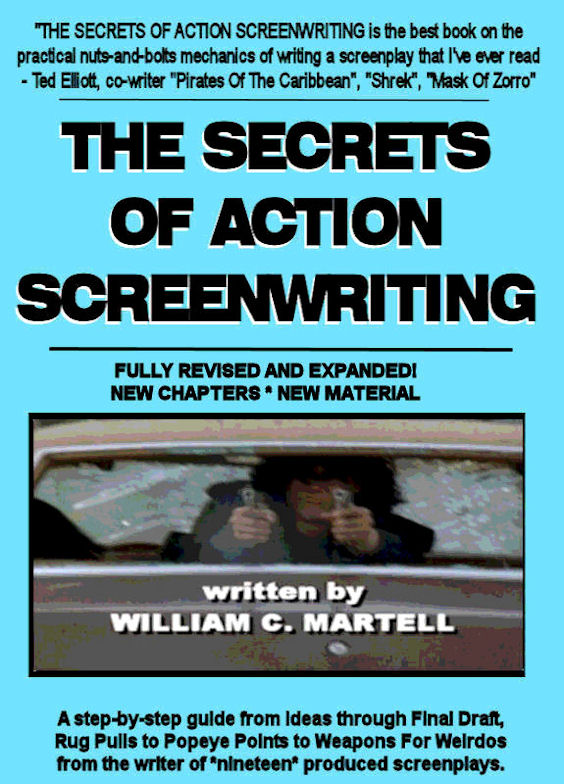
THE BOOK THAT STARTED IT ALL!
*** THE SECRETS OF ACTION SCREENWRITING *** - For Kindle!
*** THE SECRETS OF ACTION SCREENWRITING *** - For Nook!
Why pay $510 for a used version of the 240 page 2000 version that used to retail for $21.95? (check it out!) when
you can get the NEW EXPANDED VERSION - over 500 pages - for just $9.99? New chapters, New examples, New techniques!
"SECRETS OF ACTION SCREENWRITING is the
best book on the practical nuts-and-bolts mechanics of writing a screenplay I've ever read."
- Ted Elliott, co-writer of MASK OF ZORRO, SHREK, PIRATES OF THE CARIBBEAN and the sequels (with Terry Rossio). (ie; 4 of the top 20 Box Office Hits Of ALL TIME.)
Only $9.99 - and no postage!
READY TO BREAK IN?
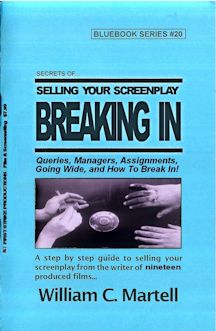
NEW!
*** BREAKING IN BLUE BOOK *** - For Kindle!
Should really be called the BUSINESS BLUE BOOK because it covers almost everything you will need to
know for your screenwriting career: from thinking like a producer and learning to speak their language,
to query letters and finding a manager or agent, to making connections (at home and in Hollywood) and
networking, to the different kinds of meetings you are will have at Studios, to the difference between
a producer and a studio, to landing an assignment at that meeting and what is required of you when you
are working under contract, to contracts and options and lawyers and... when to run from a deal!
Information you can use *now* to move your career forward! It's all here in the Biggest Blue Book yet!
Print version was 48 pages, Kindle version is over 400 pages!
$4.99 - and no postage!
NO KINDLE REQUIRED! Get the *free* app (any device, except your Mr. Coffee) on the order page on Amazon!
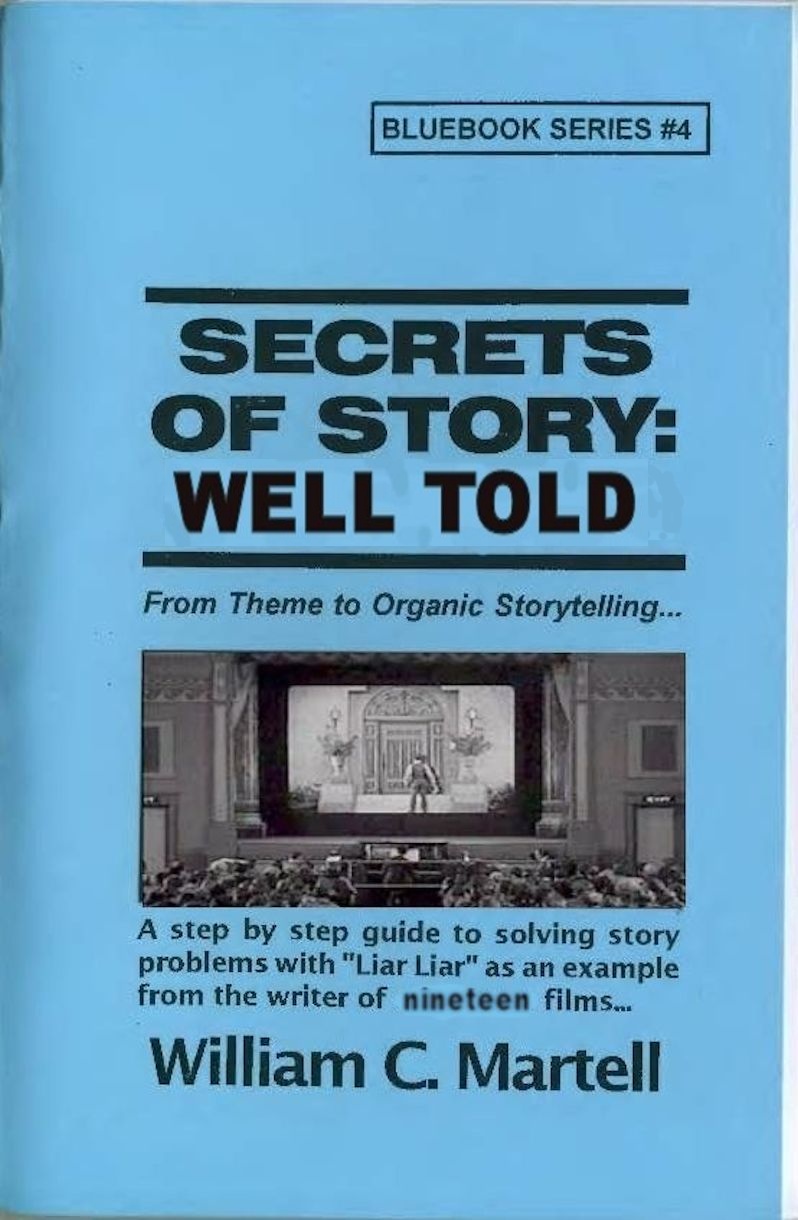
STORY: WELL TOLD!
*** STORY: WELL TOLD *** - For Kindle!
This book takes you step-by-step through the construction of a story... and how to tell a story well, why Story always starts with character... but ISN'T character, Breaking Your Story, Irony, Planting Information, Evolving Story, Leaving No Dramatic Stone Unturned, The Three Greek Unities, The Importance Of Stakes, The Thematic Method, and how to create personal stories with blockbuster potential. Ready to tell a story?
Print version was 48 pages, Kindle version is over 85,000 words - 251 pages!
Only $4.99 - and no postage!
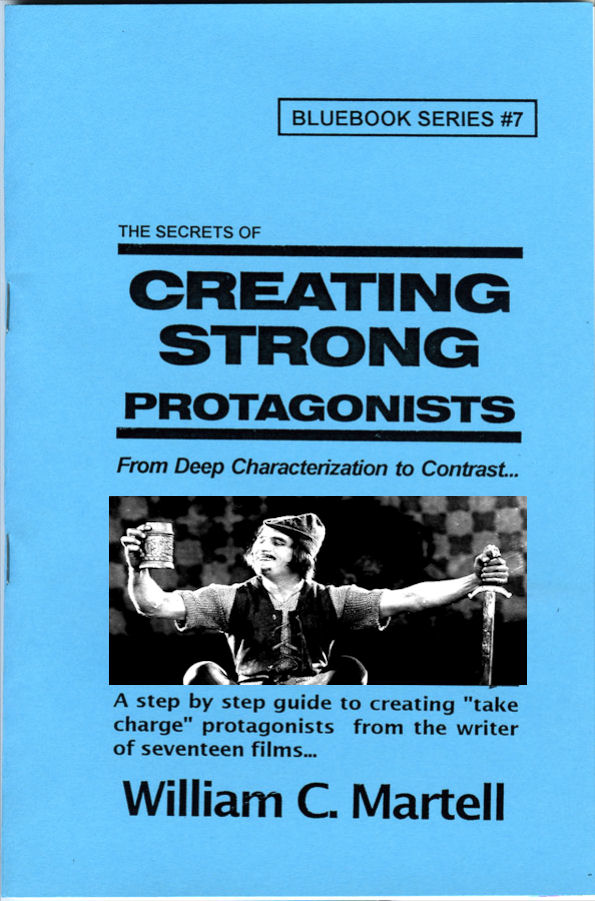
MOVIES ARE CHARACTERS!
*** CREATING STRONG PROTAGONISTS *** - For Kindle!
*** CREATING STRONG PROTAGONISTS *** - For Nook!
Expanded version with more ways to create interesting protagonists! A step-by-step guide to creating "take charge" protagonists. Screenplays are about characters in conflict... characters in emotional turmoil... Strong three dimensional protagonists who can find solutions to their problems in 110 pages. But how do you create characters like this? How do you turn words into flesh and blood? Character issues, Knowing Who Is The Boss, Tapping into YOUR fears, The Naked Character, Pulp Friction, Man With A Plan, Character Arcs, Avoiding Cliche People, Deep Characterization, Problem Protagonists, 12 Ways To Create Likable Protagonists (even if they are criminals), Active vs. Reactive, The Third Dimension In Character, Relationships, Ensemble Scripts, and much, much more. Print version is 48 pages, Kindle version is once again around 205 pages!
ONLY $4.99 - and no postage!
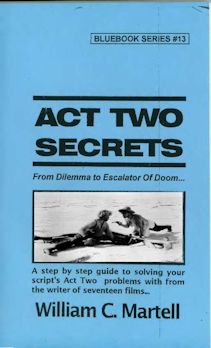
ACT TWO SOLUTIONS!
*** ACT TWO SECRETS *** - For Kindle!
Expanded version with more techniques to help you through the desert of Act Two! Subjects Include: What Is Act Two? Inside Moves, The 2 Ps: Purpose & Pacing, The 4Ds: Dilemma, Denial, Drama and Decision, Momentum, the Two Act Twos, Subplot Prisms, Deadlines, Drive, Levels Of Conflict, Escalation, When Act Two Begins and When Act Two Ends, Scene Order, Bite Sized Pieces, Common Act Two Issues, Plot Devices For Act Two, and dozens of others. Over 67,000 words (that’s well over 200 pages) of tools and techniques to get you through the desert of Act Two alive!
Print version was 48 pages, Kindle version is well over 200 pages!
ONLY $4.99 - and no postage!
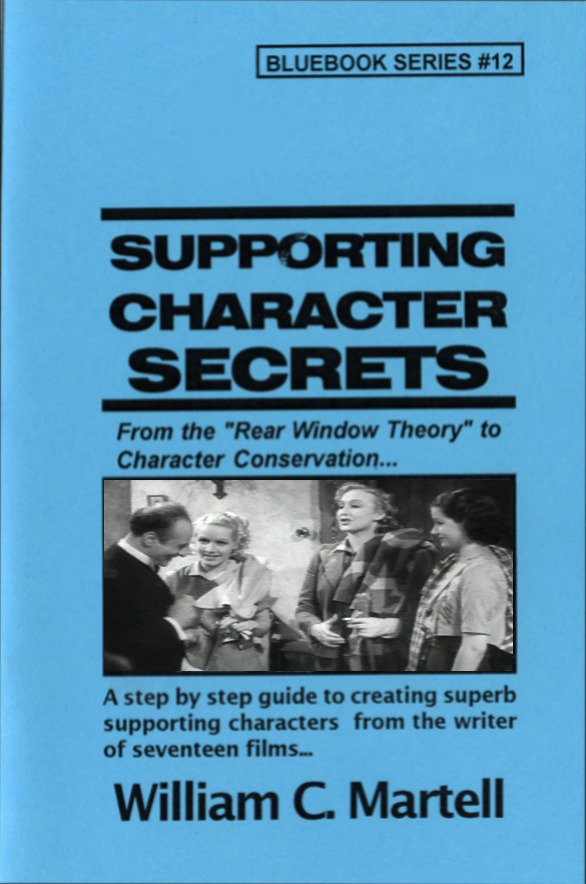
SUBPLOTS?
*** SUPPORTING CHARACTER SECRETS *** - For Kindle! (Exclusive)
Expanded version with more techniques to flesh out your Supporting Characters and make them individuals. Using the hit movie BRIDESMAIDS as well as other comedies like THE HANGOVER and TED and HIGH FIDELITY and
40 YEAR OLD VIRGIN and many other examples we look at ways to make your Supporting Characters come alive on the page.
Print version was 48 pages, Kindle version is around 170 pages!
ONLY $4.99 - and no postage!

ADVICE FROM 1920!
*** VINTAGE #1: HOW TO WRITE PHOTOPLAYS *** - For Kindle!
***
Screenwriting books have been around as long as films have. This series reprints vintage screenwriting books with a new introduction and history, plus new articles which look at how these lessons from almost 100 years ago apply to today’s screenplays. Anita Loos book is filled with information which still applies.
In addition to the full text of the original book, you get the full screenplay to Miss Loos' hit THE LOVE EXPERT, plus several new articles on the time period and women in Hollywood.
ONLY $2.99 - and no postage!
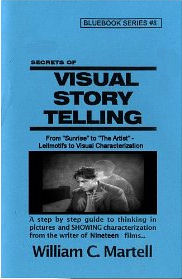
I WRITE PICTURES!
*** VISUAL STORYTELLING *** - For Kindle! (exclusive)
Show Don't Tell - but *how* do you do that? Here are techniques to tell stories visually! Using Oscar Winning Films and Oscar Nominated Films as our primary examples: from the first Best Picture Winner "Sunrise" (1927) to the Oscar Nominated "The Artist" (which takes place in 1927) with stops along the way Pixar's "Up" and Best Original Screenplay Winner "Breaking Away" (a small indie style drama - told visually) as well as "Witness" and other Oscar Winners as examples... plus RISE OF THE PLANET OF THE APES. Print version is 48 pages, Kindle version is over 200 pages!
ONLY $4.99 - and no postage!
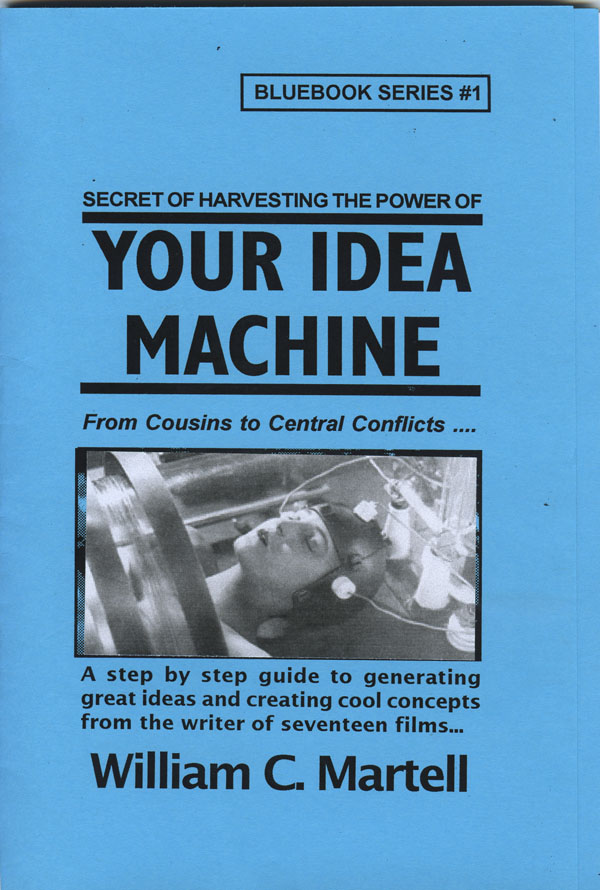
BEST SELLER!
*** YOUR IDEA MACHINE *** - For Kindle!
*** YOUR IDEA MACHINE *** - For Nook!
Expanded version with more ways to find great ideas! Your screenplay is going to begin with an idea. There are good ideas and bad ideas and commercial ideas and personal ideas. But where do you find ideas in the first place? This handbook explores different methods for finding or generating ideas, and combining those ideas into concepts that sell. The Idea Bank, Fifteen Places To Find Ideas, Good Ideas And Bad Ideas, Ideas From Locations And Elements, Keeping Track Of Your Ideas, Idea Theft - What Can You Do? Weird Ways To Connect Ideas, Combing Ideas To Create Concepts, High Concepts - What Are They? Creating The Killer Concept, Substitution - Lion Tamers & Hitmen, Creating Blockbuster Concepts, Magnification And The Matrix, Conflict Within Concept, Concepts With Visual Conflict, Avoiding Episodic Concepts, much more! Print version is 48 pages, Kindle version is over 175 pages!
Only $4.99 - and no postage!
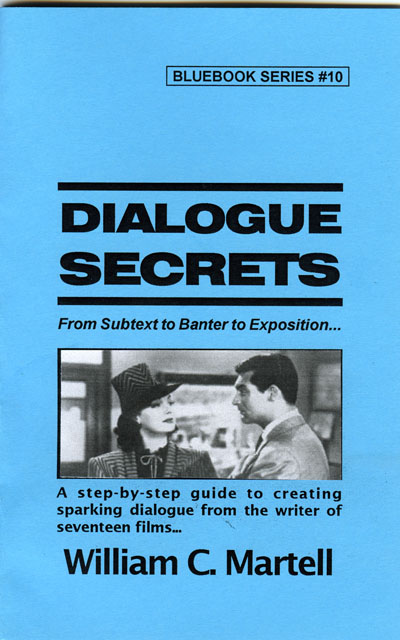
PRO DIALOGUE TECHNIQUES!
*** DIALOGUE SECRETS *** - For Kindle!
*** DIALOGUE SECRETS *** - For Nook!
Expanded version with more ways to create interesting dialogue! How to remove bad dialogue (and what *is* bad dialogue), First Hand Dialogue, Awful Exposition, Realism, 50 Professional Dialogue Techniques you can use *today*, Subtext, Subtitles, Humor, Sizzling Banter, *Anti-Dialogue*, Speeches, and more. Tools you can use to make your dialogue sizzle! Special sections that use dialogue examples from movies as diverse as "Bringing Up Baby", "Psycho", "Double Indemnity", "Notorious", the Oscar nominated "You Can Count On Me", "His Girl Friday", and many more! Print version is 48 pages, Kindle version is over 175 pages!
Only $4.99 - and no postage!

Use your creative energy to focus on the content; let Final Draft take care of the style. Final Draft is the number-one selling application specifically designed for writing movie scripts, television episodics and stage plays. Its ease-of-use and time-saving features have attracted writers for almost two decades positioning Final Draft as the Professional Screenwriters Choice. Final Draft power users include Academy, Emmy and BAFTA award winning writers like Oliver Stone, Tom Hanks, Alan Ball, J.J. Abrams, James Cameron and more.
* * * Buy It!

|

